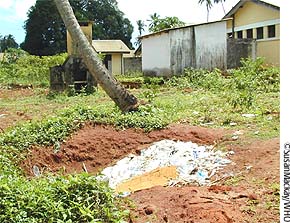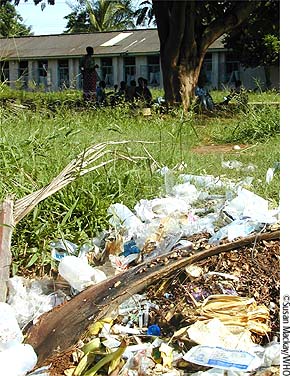 |
UPDATE - March 2002
En Français
3: West Africa: small, locally built incinerators

Wide open: clinical waste heaped in a mound in a shallow open pit in an African district hospital |
Adama Sawadogo is nicknamed le pyromane – the pyromaniac – because he has been charged with the task of overseeing the safe disposal of injection waste in a multicountry measles immunization campaign. The disposal project is one function of a WHO logistics team, headed by Souleymane Koné of WHO’s Côte d’Ivoire office in Abidjan, and covering five countries in West Africa: Burkina Faso, Mali, Togo, Benin and Ghana. The project was put together rapidly, beginning in September 2001, in time for a major measles immunization campaign starting in the region in December.
"We had to find a solution before the campaign started," says Sawadogo, an engineer by training. The team anticipated that the campaign alone would generate about 300 tonnes of injection waste across the five countries. "We had to destroy it all."
Sawadogo and his colleagues identified a simple type of incinerator, known as the De Montfort, which was devised by a British researcher, James Picken of De Montfort University, with initial funding from the UK Department of International Development. It is made of bricks that are fired to be especially resistant to heat, able to withstand the temperatures of up to 1500ºC that are necessary for waste destruction, and which can be manufactured locally.

Hazards everywhere: clinical waste at a regional hospital in east Africa |
The De Montfort has two combustion chambers and two doors: an upper door through which the safety boxes are inserted, and a lower door through which the ash can be removed after burning. The fire can be started with paper, cardboard or wood with a small quantity of firelighter. Up to four 5-litre safety boxes fit into the incinerator at once, stacked two on two.
After receiving training in the building of this incinerator from its inventor in a workshop in Bamako, the multicountry team supervised the building of 277 incinerators across the five countries. To ensure all safety boxes were burnt, each district had to record each box sent to the incinerator and an operator logged the arrival of each. Overall 65% of the campaign waste was burnt in De Montfort incinerators, and in some of the countries the figure was as high as 100%. Other methods were permitted for clinics in isolated areas in the largest districts, says Dr Sawadogo, where the distance to the nearest incinerator was too great to assure safe and economical transport.
Dr Sawadogo judges the overall performance of the incinerators during the campaign a success. He says there are a few structural problems that are being addressed with the inventor. Some of the incinerators had to work overtime, burning safety boxes from 9 am to 11 pm at the height of the campaign – particularly in Burkina where 6 million children had to be immunized. In a few cases, cracks have appeared in the bricks, suggesting that some might not have been fired at sufficiently high temperatures, while a few incinerators showed faults resulting, he believes, from the speed at which they had to be built. Nevertheless, the overall performance was efficient, affordable and manageable. "We already have proposals for improving the incinerators," he says. "At the same time, we are keeping the door open for using other methods alongside the De Montfort."
For more information contact Dr Sawadago, seamesaw@yahoo.fr or Dr Koné, kones@oms.ci
Phyllida Brown
UPDATE - Putting injection waste out of harm’s way - more
Immunization Focus March 2002 - Contents
 |
 |